Pine Siskin (Spinus pinus)

Pine Siskin (Spinus pinus) - Female
×


Pine Siskin (Spinus pinus) - Female
About Pine Siskin (Spinus pinus)
- Kingdom: Animals
- Phylum: Chordates
- Class: Birds
- Order: Perching Birds
- Family: Cardueline Finches and Allies
The pine siskin is a North American bird in the finch family. It is a migratory bird with an extremely sporadic winter range.
Source: Wikipedia
Trips
Visits
-
-
-
2008-05-10
Broderick-Terry Duel Site, United States of America -
2008-05-29
Presidio - El Polin Spring, United States of America -
2012-07-12
Yellowstone National Park, United States of America -
2013-04-15
Balcones Canyonlands NWR--Refuge HQ (Travis Co.), United States of America -
2014-07-12
Windy Hill OSP, United States of America -
2014-12-08
Golden Gate Park - San Francisco Botanical Garden, United States of America -
2015-01-03
Woodward Park, United States of America -
-
-
-
-
-




